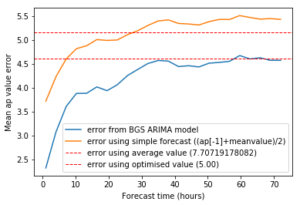First weeks: finding footing

I am now two weeks in to this project, and I am starting my first steps into the deep pond that is Space Weather. What did I do this week? I managed to get a python project going, which is not a bad start. I used some ap index predictions in order to assess the ability of an ARIMA network made by BGS to predict ‘ap’ up to 72 hours in advance (see featured image). Looking at the mean error of the forecast from the actual value, you can see that the ARIMA forecast beats both the prediction of a simple average value (7.707…) for every forecast, and the prediction of a simple forecasting algorithm which takes the previous value of the ap index (ap[-1]) and averages it out with the mean value of 7.707. On first viewing, this appears promising, and the ARIMA algorithm is useful up to the 72 hour period. However, it is clear that the algorithm fast approaches a value where the error is no longer increasing, in an almost logarithmic fashion. This implies to me that the algorithm has a maximum value of the error, no matter what the forecast time is. However, the **mean** of the values of ‘ap’ was not neccesarily the **optimal** value for reducing the mean. To find that, I used a simple trial and error optimising algorithm to a value of 2 decimal places, to find that 5.00 was equal to the best possible fit for an average value (i.e. the lowest error). This leads to an average error of 4.61815068493 ‘ap’ units, which leads to the following plot:

suddenly, the ARIMA algorithm is not so attractive: indeed, it only appears to be better than just predicting 5.00 for every value at forecast times below 30 hours (probably 60 hours if more datasets are used; it seems likely that the peak at 35 hours is simply an artifact of the data).
In conclusion, the ARIMA algorithm does not provide value for the full duration of the 72hr forecasting period. I would like to spend a little bit more time trying out different methods for calculating error (mean error is very poor, and a root mean squared error or similar would probably be a lot more useful). It However, it is clear that this algorithm is better than any other model at times less than 30hrs. Further analysis may yield a better value for the mean and the prediction efficacy curve. I will also need to work on different methods of analysis of forecast ability, and I may come back soon with a better attempt!
Data was taken from 01/01/2014 to 21/08/2014. Forecast available here: Geomagnetic Activity Indices (bgs.ac.uk)
-Sam




Recent comments